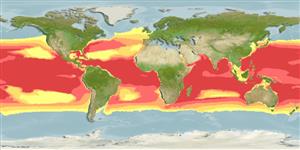>
Aulopiformes (Grinners) >
Scopelarchidae (Pearleyes)
Etymology: Scopelarchoides: Greek, skopelos = a lantern fish + Greek, archos = anus + Greek, oides = similar (Ref. 45335); danae: Named after the Danish research vessel DANA used during the major expeditions of the Carlsberg Foundation, her scientific parties and crews, and the continuing work of the Carlsberg foundation that has enhanced knowledge of the deepsea fauna (Ref. 40783).
Eponymy: The succession of Danish research vessels named ‘Dana’ seem to have been greatly favoured by describers of fish, and often the etymology includes: “…from which the holotype was collected. [...] (Ref. 128868), visit book page.
Environment: milieu / climate zone / пределы глубины / distribution range
экология
морской батипелагический; мигрирует в океане (Ref. 51243); пределы глубины 0 - 1850 m (Ref. 58018). Deep-water
Circumglobal: In tropical to subtropical waters; except Mediterranean Sea. Eastern Central Atlantic: numerous records within the area, all but one are from stations within the Gulf of Guinea (ca 5°N to 11°S and east of 15°W). Western Indian Ocean: numerous records from the Mozambique Channel and off Xai-Xai, Mozambique (Ref. 6601). Western Central Pacific: known only from 2 adult specimens, one collected from near New Caledonia and one from near the Marquesas (Ref. 40783). South China Sea (Ref.74511).
Size / Вес / Возраст
половая зрелость: Lm ? range ? - ? cm
Max length : 12.3 cm SL самец/пол неопределен; (Ref. 13608)
колючие лучи спинного плавника (общее число) : 0; членистые (мягкие) лучи спинного плавника (общее число) : 6 - 9; колючие лучи анального плавника: 0; членистые (мягкие) лучи анального плавника: 24 - 27. Dark stripe just below lateral line and extends to lower caudal lobe (Ref. 6601). Pigments lacking on pectoral and pelvic fins; gill filaments not extending to edge of gill covers (Ref. 13608).
Body shape (shape guide): elongated.
Oceanic and mesopelagic (Ref. 6601, 75154). Adults have usually been taken in hauls at depths between 300 to 800 m; most larvae in hauls to depths between 0 to 200 m. Most records in all areas are from localities near continental or insular land masses. Synchronous hermaphrodites (Ref. 10755).
Life cycle and mating behavior
половая зрелость | размножение | нерест | икра | Fecundity | личинки
Johnson, R.K., 1990. Scopelarchidae. p. 393-397. In J. C. Quero, J. C. Hureau, C. Karrer, A. Post and L. Saldanha (eds.) Check-list of the fishes of the eastern tropical Atlantic (CLOFETA). JNICT, Lisbon; SEI, Paris; and UNESCO, Paris. Vol. 1. (Ref. 10755)
Статус Красного Списка МСОП (Ref. 130435: Version 2024-2)
Угроза для людей
Harmless
Использование человеком
рыболовство: интереса не представляет
дополнительная информация
инструменты
Специальные отчеты
Скачать в формате XML
ресурсы в Интернет
Estimates based on models
Preferred temperature (ссылка
123201): 5.9 - 15.4, mean 9.5 °C (based on 1087 cells).
Phylogenetic diversity index (ссылка
82804): PD
50 = 0.5313 [Uniqueness, from 0.5 = low to 2.0 = high].
Bayesian length-weight: a=0.00347 (0.00143 - 0.00840), b=3.16 (2.94 - 3.38), in cm total length, based on LWR estimates for this (Sub)family-body shape (Ref.
93245).
Trophic level (ссылка
69278): 4.2 ±0.8 se; based on size and trophs of closest relatives
Fishing Vulnerability (Ref.
59153): Low vulnerability (10 of 100).
🛈
